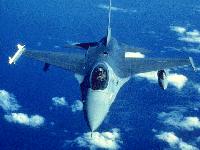




 The Podded Reconnaissance System (PRS) provides a responsive �under-the-weather� reconnaissance capability to support intelligence and targeting requirements of military, multinational, and other government agency users. It provides a dedicated, on-demand, day/under-the-weather, selective aspect, literal imagery collection capability. It fills the high-threat, under-the-weather niche that cannot be accomplished by existing collectors such as space systems, Unmanned Aerial Vehicles, and the U-2. The PRS supports Combat Air Force (CAF) Mission Need Statement 328-93, Theater Airborne Reconnaissance System.
The Podded Reconnaissance System (PRS) provides a responsive �under-the-weather� reconnaissance capability to support intelligence and targeting requirements of military, multinational, and other government agency users. It provides a dedicated, on-demand, day/under-the-weather, selective aspect, literal imagery collection capability. It fills the high-threat, under-the-weather niche that cannot be accomplished by existing collectors such as space systems, Unmanned Aerial Vehicles, and the U-2. The PRS supports Combat Air Force (CAF) Mission Need Statement 328-93, Theater Airborne Reconnaissance System.
PRS consists of 20 podded systems with embedded electro-optical (EO) sensor suites, five transportable Squadron Ground Stations, logistics support, and spares. This project includes tasks to develop and integrate the PRS on Air National Guard F-16C Block 30 aircraft. The PRS Initial Configuration Criteria (ICC) system will provide a single forward looking EO framing sensor, sensor control, second sensor window, data recording, and internal pod environmental control. The pod will interface with the F-16 cockpit Electronic Warfare Management System. The ICC system will also provide space and environmental control required to implement the Final Configuration Criteria (FCC) capabilities consisting of a second vertical/oblique EO sensor and provisions for a P3I (Pre-Planned Product Improvement) Common Data Link. FCC capability will be based on the integration of a Navy/Marine production Medium Altitude EO sensor.
The new PRS technology attaches to the rear of the camera, built by Recon Optical, stores images digitally. Advances in digital imaging allow this system to save entire images on a photo-sensitive computer chip. The pod and its related technologies offer high-quality images, enhanced exploitation capabilities and high-speed transmission. The digital imagery also ends the need for time-consuming wet- film development. The camera can take two to three pictures each second, sending single-frame images to a recorder which can store 12,000 images. The Lockheed unit hangs directly off the belly of the 192nd's modified F-16s. Carrying the pod on the aircraft's centerline allows the F-16 to remain fully armed and able to support air-to-air and air-to-ground missions while gathering intelligence imagery.
